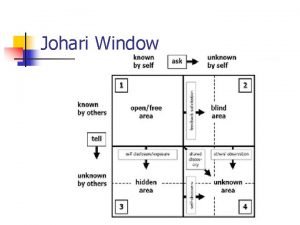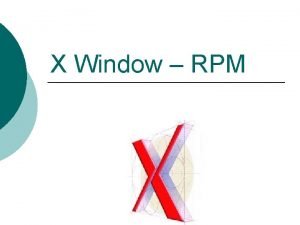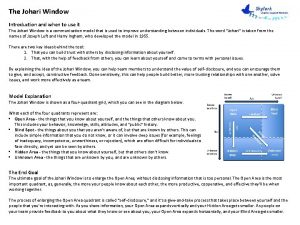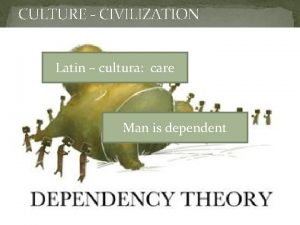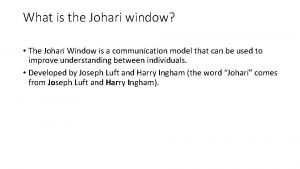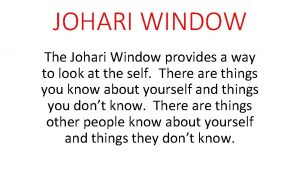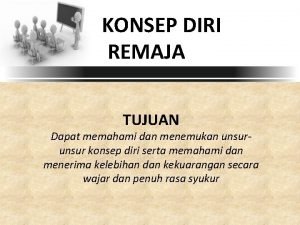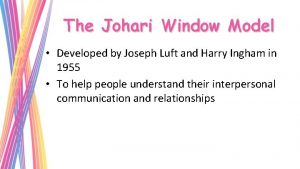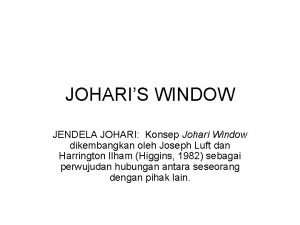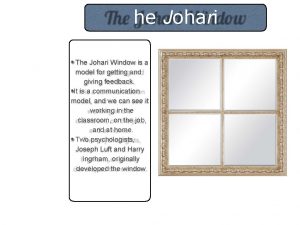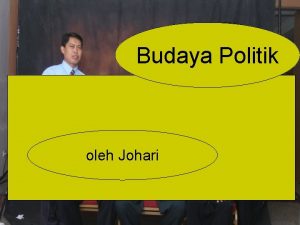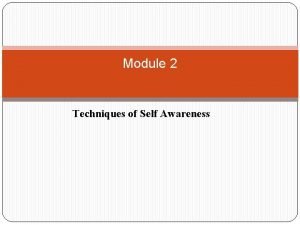Johari Window Content What is Johari Window Founders

















- Slides: 17

Johari Window

Content • • What is Johari Window ? Founders Formation of Name Influence of Model Use of Johari Window What model represents Areas of Model Drawbacks of Model

Johari Window A model for self- awareness, personal development, group development and understanding relationship.

Founders • The Johari Window model was devised by American psychologists Joseph Luft and Harry Ingham in 1955, while researching group dynamics at the University of California Los Angeles. • The model was first published in the Proceedings of the Western Training Laboratory in Group Development by UCLA Extension Office in 1955, and was later expanded by Joseph Luft.

Formation of Name • Luft and Ingham called their Johari Window model 'Johari' after combining their first names, Joe and Harry. In early publications the word appears as 'Jo. Hari'.

Influence �Today the Johari Window model is especially relevant due to modern emphasis on, and influence of • soft skills • behaviour • empathy • cooperation • inter-group development • interpersonal development.

Use of Johari Model • The Johari Window soon became a widely used model for understanding and training self-awareness, personal development, improving communications, interpersonal relationships, group dynamics, team development and intergroup relationships.

What actually Model Represents • The Johari Window model is also referred to as a 'disclosure/feedback model of self awareness', and by some people an 'information processing tool'. • The Johari Window actually represents information - feelings, experience, views, attitudes, skills, intentions, motivation, etc within or about a person - in relation to their group, from four perspectives.

Areas of Model • The four Johari Window perspectives are called 'regions' or 'areas' or 'quadrants'. Each of these regions contains and represents the information - feelings, motivation, etc – known about the person, in terms of whether the information is known or unknown by the person, and whether the information is known or unknown by others in the group.

Johari window four quadrants 1. what is known by the person about him/herself and is also known by others - open area, open self, free area, free self, or 'the arena‘. 2. what is unknown by the person about him/herself but which others know - blind area, blind self, or 'blindspot‘. 3. what the person knows about him/herself that others do not know - hidden area, hidden self, avoided area, avoided self or 'facade‘. 4. what is unknown by the person about him/herself and is also unknown by others - unknown area or unknown self.

Johari window four quadrants

Johari quadrant 1 • Johari region 1 is also known as the 'area of free activity'. This is the information about the person - behaviour, attitude, feelings, emotion, knowledge, experience, skills, views, etc known by the person ('the self') and known by the group ('others').

Johari quadrant 2 • Johari region 2 is what is known about a person by others in the group, but is unknown by the person him/herself.

Johari quadrant 3 • what is known to ourselves but kept hidden from, and therefore unknown to others.

Johari quadrant 4 • It contains information, feelings, talent abilities, aptitudes, experiences etc, that are unknown to the person him/herself and unknown to others in the group.

Unknown factors • an ability that is under-estimated or un-tried through lack of opportunity, encouragement, confidence or training. • a natural ability or aptitude that a person doesn't realise they possess • a fear or aversion that a person does not know they have • an unknown illness • repressed or subconscious feelings • conditioned behaviour or attitudes from childhood

Drawbacks of Johari window • Some thing are perhaps better not to Communicated (like mental or health problem) • Some people may pass on the information they received further then we desire. • Some people may react negatively. • Using johari window is useless exercise if it is not linked to the activities that reinforce positive behavior or that correct negative behavior. • Some cultures have a very open and accepting approach to feedback and others do not. • Some people take personal feedback offensively.
 Johari window founder
Johari window founder Humanmetrics myers briggs
Humanmetrics myers briggs Fildem global menu gnome 40
Fildem global menu gnome 40 Konsep jendela johari
Konsep jendela johari Kuadran 1 pada jendela johari
Kuadran 1 pada jendela johari Belbin johari window
Belbin johari window Johari window feedback
Johari window feedback Joharivinduet
Joharivinduet Yipsir
Yipsir Teori johari window
Teori johari window Ethnocentrism
Ethnocentrism Johari window handout
Johari window handout Konsep jendela johari
Konsep jendela johari Belbin team roles
Belbin team roles Johari window model
Johari window model Konsep diri
Konsep diri Analyse swot
Analyse swot Joseph luft and harry ingham
Joseph luft and harry ingham

